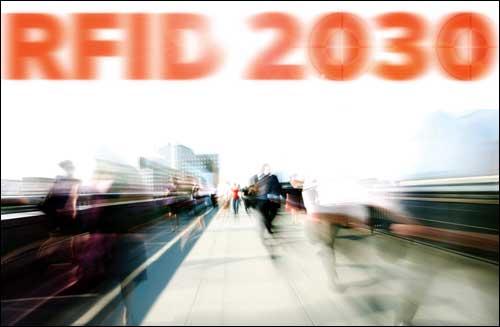All CEOs wish they had a crystal ball, so they could see the future and prepare for it rather than simply react to change. Unfortunately, there’s no way to know what the world will be like in, say, 20 years. But we believe radio frequency identification will be widely adopted by 2030 and will have a profound impact not just on the way companies do business, but on the way people shop, travel, learn and more.
Exactly how this growth will take place isn’t clear, but there are signs. Technology providers that promote the benefits of RFID and deliver solutions to solve specific business problems, providing a fast return on investment, will lead the way. At the same time, companies that use the technology—to track assets and inventory, streamline operations and business processes, or provide customer services—will create and leverage an RFID infrastructure to achieve even more benefits.
|
|
In the scenarios on the following pages, we imagine what the world will be like in 2030. Read them, then ask yourself where your company will be 20 years from today. Will you be powering or using the solutions that attract shoppers to retail stores, expedite product shipments, put the joy back in travel, enhance education, simplify chores and save lives? Or will you be playing catch-up?
* * *
Amelia Hartear loved everything about being CEO of AirWell, a midsize aircraft parts manufacturer. Twenty years ago, when she’d talked the board into hiring her, the small company was on the edge of bankruptcy. They’d been impressed with her confidence and her vision to streamline manufacturing processes, reduce costs and improve quality through investments in new technologies. Their gamble in her—and hers in an emerging technology called RFID—had propelled the company out of the red and ahead of the competition.
Today, she could show the board that AirWell had once again earned a top spot on Aviation Supply magazine’s list of best companies in the industry. The editors cited AirWell’s reliable and innovative products—spark plugs designed to reduce wear; heat-resistant harnesses engineered to provide greater energy efficiency; and turbine engine ignition systems that improve performance.
But that would have to wait. First on her agenda was a meeting with Lindy Charles, senior manager of operations, at the plant next to AirWell’s corporate offices in Kansas City, Mo., to discuss a number of projects under way to further streamline processes. Charles was particularly enthusiastic about a pilot program that enabled AirWell to immediately locate all the components needed to meet rush or special custom orders and get them to the line at precisely the right time.
“The system got a real workout when we received an emergency call for power-supply units,” Charles told Hartear. “The components were in multiple places—the yard, the warehouse…some were just arriving at the dock. But it all worked as advertised.”
“That’s what I like to hear,” Hartear responded. “It didn’t cost much to deploy, since we had the RFID infrastructure in place. And the margins on those rush orders are pretty. Do you think the system is ready to be deployed companywide?”
“Oh, definitely.”
“Great. Let’s do it.”
Charles was updating Hartear on another project when supply-chain executive VP Orville Wilbur walked in. “I had my people check online and locate the glass seals we’re running low on for the Hoppeywell sparkplug order,” Wilbur said. “Wing of the Dove Manufacturing, which makes them in China, just uploaded data indicating the tagged pallets cleared customs in minutes. Security checks move so much faster now that agents can verify the container seal data with the information they pull up online from the EPC Information Services database.
“Now that we’ve contracted with an RFID-equipped trucking fleet, the shipment will be expedited from the Port of Long Beach—the truck’s contents and billing information will be captured automatically, so the trucks won’t lose time stopping for inspections and credentials verification,” Wilbur added. “We’ll receive the glass seals in plenty of time to fulfill the order.”
“That’s good news,” Hartear said. “I know we want to keep our supply chain lean, but Hoppeywell is our biggest order this quarter in that area of the business, and not one we could have afforded to mess up.”
“Speaking of the supply chain, Amelia, it looks like FlyRight has become the best choice to serve as our sole supplier for tungsten high-density aviation parts,” Wilbur said.
AirWell had been sourcing most of that business to the larger and more established supplier Gigantium, but Wilbur had met the charismatic president of FlyRight—a much smaller competitor—at a trade show, and after doing his due diligence had decided to give it a chance. Initially, FlyRight had handled less than 5 percent of AirWell’s orders in this area, but in the past five years, it had worked its way up to fulfilling close to 20 percent. Over that time, Wilbur’s team had been closely monitoring the performance of FlyRight’s components against Gigantium’s.
“We can now look back on a performance scorecard with five years of end-to-end data on FlyRight and Gigantium components,” Wilbur continued. “We tracked each part from delivery through to the manufacturing line and all the way to how the final product—and each component in it—performed in customer installations. In the past three years, the number of defective Gigantium parts has risen 18 percent, and their on-time delivery rate has fallen 11 percent.
“But fewer than 1.3 percent of FlyRight components failed, and their on-time delivery rate is 99.9 percent, thanks to the RFID system we encouraged them to intall.”
Hartear thanked Charles and Wilbur for their valuable input, then headed out to a videoconference she had scheduled with Beryl Markem, who was working in Memphis, Tenn. Markem was the executive VP at what had been Tire & Rubber, a manufacturer and distributor of aircraft tires and tubes that AirWell had purchased for a song three years ago, following a series of tire blowouts on landings. Hartear had been sure AirWell could turn things around, and she had tapped Markem, her senior director of quality assurance, to drive the change.
And a big change it was. Markem instituted procedures to monitor not only work in process but every raw material—from nylon fabrics to specialized rubber compounds—that went into tire production, to ensure that each met required quality standards. She’d had a hard sell both up and down the supply chain—suppliers had balked at the extra expense, and buyers were still leery of trusting the company’s products. Markem had cut deals with suppliers to help them with tagging costs and drastically lowered prices for buyers, while also giving them real-time views into the data to satisfy their concerns. She also gave them the opportunity to cut and run if they weren’t happy with the data they were seeing.
“One year after delivering our first shipment of end-to-end tracked tires, our customers are more satisfied than ever,” Markem said. The company had seen its own maintenance costs drop as quality now surpassed that of any rival products on the market, new orders poured in, and tagging costs shifted back to the suppliers, who were saving money from internally tracking parts.
“Good work,” Hartear said. “I’ll see you next month live for the big trade show.” She looked at her watch, adding, “I’ve got to run to make my flight.” AirWell was profitable, but Hartear, like many corporate executives worldwide, had signed a pact to fly commercial rather than private jets, to help curb global warming.
Two and a half hours later, she was sitting in a conference room with Saul E. Berger, CEO of Tier One aircraft supplier HF Aviation, which bought many of AirWell’s products for installation in the large subsystems it sold directly to major aircraft manufacturers. HF was one of the companies reaping the benefits of AirWell’s decision to use FlyRight’s high-quality tungsten components—HF’s own maintenance and repair costs had fallen significantly. Hartear was gracefully playing up that strength as the conversation segued into the terms of their next contract. She was hoping to drive home the message that this was just one example of the level of transparency AirWell had into its supply chain and manufacturing line.
The better visibility AirWell had into its finished parts—many of which looked similar but for small differences the eye hardly registered—also led to other benefits for HF. AirWell sent advanced shipping notices, so HF would know exactly which parts to expect, and when. Its employees could check deliveries instantly upon arrival, scanning tagged shipments to ensure they contained the right parts, quantity and type—catching any potential errors before they could wreak havoc with the production process.
Hartear saw an opportunity to change the relationship with HF from a purely transactional one, where Airwell was paid following invoicing or penalized for lateness, to something more progressive. She had a vision of a more collaborative business model, built on the benefits they both gained from sharing and leveraging data. She thought, for example, that the new model might involve HF assuming some of AirWell’s carrying costs, given AirWell’s proven ability as a premium supplier of high-quality systems at greater speed and lower costs. She knew this chat was just going to be the start of what would likely be a long negotiation, and she was ready for it.
“So, what’s new with AirWell?” Berger asked her.
“Saul,” Hartear said, “let me tell you what’s right with AirWell. And why everything that’s going right with us is a big plus for HF.” With that, the two got down to some productive business.
On the way back to the airport, Hartear called the office. “Orville,” she said, “nothing’s signed with HF yet, but I have a good feeling that in the not-so-distant future, we’re going to need to significantly increase our orders with FlyRight, and with a bunch of other suppliers, too.”
Photos and illustrations: iStock Photo. Cover photo: René Mansi/iStock Photo
* * *
We’d like to thank the following people for sharing their insight and expertise to help us look into RFID’s future:
• Magda Balazinska, assistant professor, department of computer science and engineering, University of Washington
• Venkat Krishnamurthy, CTO, Checkpoint Systems
• Michael Liard, RFID practice director, ABI Research
• Mike Liebhold, senior researcher, Institute for the Future
• June Ruby, director of manufacturing solutions group, Motorola Enterprise Mobility Solutions
• Alan Sherman, director of marketing, OATSystems
• Chris Warner, senior product manager of RFID, Motorola Enterprise Mobility Solutions
To read more RFID scenarios from the year 2030, click here.



